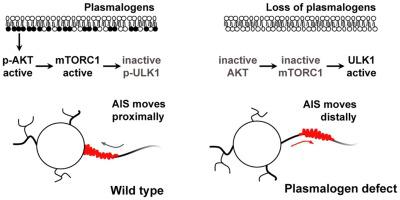Progress in Neurobiology ( IF 6.7 ) Pub Date : 2021-07-21 , DOI: 10.1016/j.pneurobio.2021.102123 Tiago Ferreira da Silva 1 , Luís S Granadeiro 1 , Diogo Bessa-Neto 1 , Liliana L Luz 2 , Boris V Safronov 2 , Pedro Brites 1

|
The axon initial segment (AIS) is a specialized region in neurons that encompasses two essential functions, the generation of action potentials and the regulation of the axodendritic polarity. The mechanism controlling the position of the axon initial segment to allow plasticity and regulation of neuron excitability is unclear. Here we demonstrate that plasmalogens, the most abundant ether-phospholipid, are essential for the homeostatic positioning of the AIS. Plasmalogen deficiency is a hallmark of Rhizomelic Chondrodysplasia Punctata (RCDP) and Zellweger spectrum disorders, but Alzheimer’s and Parkinson’s disease, are also characterized by plasmalogen defects. Neurons lacking plasmalogens displaced the AIS to more distal positions and were characterized by reduced excitability. Treatment with a short-chain alkyl glycerol was able to rescue AIS positioning. Plasmalogen deficiency impaired AKT activation, and we show that inhibition of AKT phosphorylation at Ser473 and Thr308 is sufficient to induce a distal relocation of the AIS. Pathway analysis revealed that downstream of AKT, overtly active ULK1 mediates AIS repositioning. Rescuing the impaired AKT signaling pathway was able to normalize AIS position independently of the biochemical defect. These results unveil a previously unknown mechanism that couples the phospholipid composition of the neuronal membrane to the positional assembly of the AIS.
中文翻译:

缩醛磷脂通过调节 AKT-ULK1 信号通路来控制轴突起始段的位置
轴突初始段 (AIS) 是神经元中的一个特殊区域,包括两个基本功能,即动作电位的产生和轴突极性的调节。控制轴突初始段位置以允许可塑性和调节神经元兴奋性的机制尚不清楚。在这里,我们证明缩醛磷脂是最丰富的醚磷脂,对于 AIS 的稳态定位至关重要。缩醛磷脂缺乏是根状软骨发育不良 (RCDP) 和齐薇格谱系疾病的标志,但阿尔茨海默病和帕金森病也以缩醛磷脂缺陷为特征。缺乏缩醛磷脂的神经元将 AIS 移位到更远端的位置,并且其特征是兴奋性降低。用短链烷基甘油治疗能够挽救 AIS 定位。纤溶酶原缺乏会损害 AKT 活化,我们表明抑制 Ser473 和 Thr308 处的 AKT 磷酸化足以诱导 AIS 的远端重新定位。通路分析显示,在 AKT 下游,明显活跃的 ULK1 介导 AIS 重新定位。拯救受损的 AKT 信号通路能够独立于生化缺陷使 AIS 位置正常化。这些结果揭示了一种以前未知的机制,该机制将神经元膜的磷脂成分与 AIS 的位置组装相结合。通路分析显示,在 AKT 下游,明显活跃的 ULK1 介导 AIS 重新定位。拯救受损的 AKT 信号通路能够独立于生化缺陷使 AIS 位置正常化。这些结果揭示了一种以前未知的机制,该机制将神经元膜的磷脂成分与 AIS 的位置组装相结合。通路分析显示,在 AKT 下游,明显活跃的 ULK1 介导 AIS 重新定位。拯救受损的 AKT 信号通路能够独立于生化缺陷使 AIS 位置正常化。这些结果揭示了一种以前未知的机制,该机制将神经元膜的磷脂成分与 AIS 的位置组装相结合。











































 京公网安备 11010802027423号
京公网安备 11010802027423号